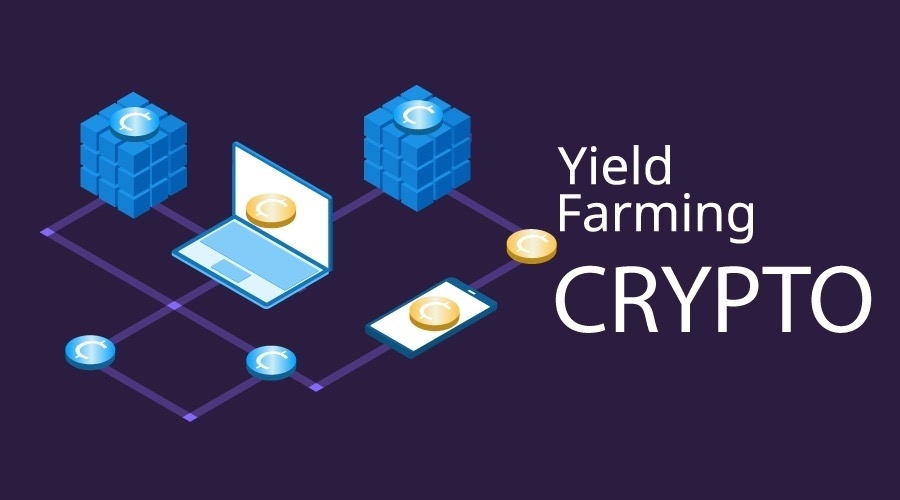
Crypto Yield Farming has emerged as a revolutionary concept within the cryptocurrency space, redefining how users interact with decentralized finance (DeFi) protocols.
At its core, yield farming refers to the practice of leveraging crypto assets to generate passive income through various DeFi mechanisms. This strategy has gained significant traction due to its potential for lucrative returns and innovative use of blockchain technology.
In essence, yield farming enables users to earn passive income by providing liquidity to DeFi protocols. Unlike traditional savings accounts or investment vehicles, which often offer fixed or predictable returns, yield farming offers the opportunity to capitalize on the dynamic nature of decentralized finance.
By allocating their crypto assets to liquidity pools or other yield-generating mechanisms, users can earn rewards through interest, fees, or governance tokens.
The Significance of Crypto Yield Farming
The significance of crypto yield farming lies in its ability to democratize access to financial opportunities previously reserved for institutional investors or high-net-worth individuals.
Through DeFi protocols, anyone with an internet connection and crypto assets can participate in yield farming, levelling the playing field and empowering individuals to take control of their financial futures.
Moreover, yield farming is vital in fostering liquidity within the DeFi ecosystem. By incentivizing users to provide liquidity to decentralized exchanges (DEXs) and lending platforms, yield farming contributes to the efficient functioning of these protocols, enhancing price discovery and reducing slippage for traders.
Overall, yield farming represents a paradigm shift in how individuals engage with finance, offering new avenues for passive income generation and financial empowerment.
How Yield Farming Works?
Yield farming operates on the principle of incentivizing users to provide liquidity to decentralized finance (DeFi) protocols in exchange for rewards. The mechanics of yield farming involve several key processes, including liquidity provision, staking, and yield aggregation.
Liquidity Provision
Liquidity provision is the foundation of yield farming. Users contribute their crypto assets to liquidity pools, which are essentially smart contracts that facilitate trading on decentralized exchanges (DEXs) or lending platforms. By adding funds to these pools, users help maintain sufficient liquidity for trading pairs, which in turn enables smooth and efficient transactions within the DeFi ecosystem.
Staking
Staking is another integral aspect of crypto yield farming. Once users have provided liquidity to a pool, they receive liquidity provider (LP) tokens as proof of their stake.
These LP tokens represent the user’s share of the pool’s assets and entitle them to a portion of the transaction fees generated by the protocol. Additionally, some DeFi platforms offer governance tokens as rewards for staking, giving users a say in the platform’s future development and direction.
Yield Aggregation
Yield aggregation involves maximizing returns by optimizing the allocation of assets across various yield farming opportunities.
Users can employ strategies such as yield optimization protocols, which automatically rebalance their assets to capitalize on the most lucrative farming opportunities available. This may involve shifting funds between different pools or protocols to achieve the highest possible yields.
Impermanent loss is a critical concept that liquidity providers must understand when participating in yield farming.
It refers to the temporary loss of value experienced by liquidity providers due to fluctuations in the price of the assets in the liquidity pool.
When the price of one asset in the pool diverges significantly from the other, liquidity providers may suffer losses when withdrawing their funds. However, impermanent loss is only realized if the liquidity provider withdraws their liquidity from the pool.
In many cases, the rewards earned from yield farming can offset or even outweigh the losses incurred from impermanent loss.
Understanding the mechanics of yield farming and mitigating risks such as impermanent loss is essential for maximizing returns and minimizing potential drawbacks.
Yield Farming Strategies
Yield farming encompasses a diverse range of strategies tailored to optimize returns and mitigate risks within the decentralized finance (DeFi) ecosystem. Some popular yield-farming strategies include liquidity mining, yield optimization, and yield farming aggregators.
Liquidity Mining
Liquidity mining is perhaps the most well-known yield farming strategy, involving the provision of liquidity to DeFi protocols in exchange for rewards.
Users contribute their assets to liquidity pools on platforms like Uniswap or SushiSwap and receive rewards in the form of transaction fees and governance tokens. By continuously providing liquidity, users can earn a steady stream of passive income while facilitating decentralized trading.
Yield Optimization
Yield optimization strategies focus on maximizing returns by dynamically reallocating assets across different yield farming opportunities.
Automated tools and protocols such as Yearn.Finance or Harvest Finance helps users identify and capitalize on the most lucrative farming opportunities available.
These platforms utilize algorithms to rebalance users’ portfolios and allocate funds to the pools offering the highest yields, optimizing returns while minimizing risks.
Yield Farming Aggregators
Yield farming aggregators streamline the process of yield farming by aggregating liquidity across multiple protocols and optimizing returns through smart contract automation.
Example: Let’s say you deposit $1000 worth of Ethereum (ETH) into a yield farming aggregator. The aggregator might:
- Identify that Protocol A offers the highest yield for ETH staking right now.
- Automatically transfer your $1000 ETH to Protocol A and stake it for you.
- Continuously monitor other protocols. If Protocol B starts offering a better yield, the aggregator can automatically unstake your ETH from Protocol A (using a smart contract) and Transfer your ETH to Protocol B. It will stake your ETH in Protocol B to maximize your returns.
Essentially, the aggregator does the research, monitoring, and optimization for you, saving you time and potentially increasing your returns.
Keep in mind:
- There might be fees associated with using a yield farming aggregator.
- Smart contracts, while powerful, can have vulnerabilities. It’s important to choose a reputable aggregator with a good security record.
Platforms like APY.Finance offers users a one-stop solution for accessing a wide range of crypto yield farming opportunities and maximizing their returns with minimal effort.
By leveraging these aggregators, users can diversify their farming strategies and achieve higher yields while reducing the complexity associated with managing multiple protocols.
Successful yield farming strategies often involve a combination of these approaches, tailored to individual risk tolerance and investment goals.
For example, a user may allocate a portion of their assets to liquidity mining on a high-yield protocol while using yield optimization tools to dynamically adjust their portfolio allocation based on market conditions.
By diversifying across multiple strategies and platforms, users can mitigate risks and maximize their overall returns in the rapidly evolving landscape of DeFi.
Popular Yield Farming Platforms
In the vibrant landscape of DeFi, several platforms have emerged as leaders in offering lucrative crypto yield farming opportunities. Let’s delve into some of the most popular platforms and their unique features:
Compound

Compound is a decentralized lending protocol that allows users to lend and borrow various crypto assets. Through its liquidity mining program, Compound incentivizes users to supply assets to its liquidity pools in exchange for COMP tokens, the platform’s governance token.
Supported assets include stablecoins like DAI, USDC, and USDT, as well as popular cryptocurrencies like Ethereum (ETH) and Wrapped Bitcoin (WBTC).
The potential returns from yield farming on the Compound vary depending on factors such as asset volatility and market demand but can reach double-digit annual percentage yields (APY).
Aave

Aave is a decentralized lending and borrowing protocol that enables users to earn interest on deposited assets and borrow funds with collateral.
Aave’s liquidity mining program rewards users with AAVE tokens for providing liquidity to its pools, which include a wide range of crypto assets such as ETH, LINK, and SNX. Yield farming on Aave offers competitive returns, with APYs often exceeding traditional savings accounts and centralized lending platforms.
Uniswap

Uniswap is a decentralized exchange (DEX) protocol that facilitates automated token swaps and liquidity provision through liquidity pools.
Uniswap’s liquidity mining program incentivizes users to provide liquidity to its pools by rewarding them with UNI tokens, the platform’s governance token. Supported assets on Uniswap include a diverse array of ERC-20 tokens, enabling users to participate in yield farming opportunities across various markets.
Potential returns from yield farming on Uniswap can be substantial, especially for highly liquid trading pairs.
Curve Finance

Curve Finance is a decentralized exchange optimized for stablecoin trading and low slippage. Through its liquidity mining program, Curve rewards users with CRV tokens for providing liquidity to its stablecoin pools, such as DAI, USDC, and USDT.
Yield farming on Curve offers attractive returns due to its focus on stablecoin liquidity provision, with APYs often surpassing those of traditional savings accounts and centralized exchanges.
These popular crypto yield farming platforms represent just a fraction of the diverse ecosystem of DeFi protocols offering lucrative opportunities for passive income generation.
By exploring the features and supported assets of each platform, users can diversify their yield farming strategies and maximize their potential returns within the dynamic landscape of decentralized finance.
Risks and Considerations
Yield farming in DeFi offers the potential for lucrative returns, but it’s essential to be aware of the various risks involved:
Smart Contract Vulnerabilities: Smart contracts underpinning DeFi protocols are susceptible to bugs, vulnerabilities, and exploits.
A flaw in the code could result in the loss of funds for liquidity providers or even the entire collapse of a protocol. Conducting thorough audits and due diligence on the security practices of DeFi platforms can help mitigate this risk.
Market Volatility: The cryptocurrency market is highly volatile, with prices of assets subject to rapid fluctuations.
Sudden price swings can affect the value of assets held in liquidity pools, leading to impermanent loss for liquidity providers. Diversifying across different assets and employing risk management strategies can help mitigate the impact of market volatility on crypto yield farming returns.
Impermanent Loss: Impermanent loss occurs when the value of assets in a liquidity pool diverges significantly from their initial value.
Liquidity providers may incur losses when withdrawing their funds from the pool, especially during periods of high volatility or one-sided price movements.
Understanding the concept of impermanent loss and its implications is crucial for managing risk when participating in crypto yield farming.
Regulatory Uncertainty: DeFi operates in a rapidly evolving regulatory landscape, with governments worldwide grappling to establish frameworks for governing decentralized finance activities.
Regulatory crackdowns or changes in compliance requirements could impact the legality and viability of certain yield farming strategies. Staying informed about regulatory developments and complying with applicable laws and regulations is essential for mitigating regulatory risk.
To manage these risks effectively, consider implementing the following risk management strategies and due diligence measures:
- Start small: Begin with a conservative approach and only allocate funds that you can afford to lose.
- Diversify: Spread your investments across different protocols, assets, and yield farming strategies to reduce concentration risk.
- Conduct thorough research: Investigate the reputation, security practices, and track record of DeFi platforms before participating in yield farming.
- Stay updated: Keep abreast of market trends, security vulnerabilities, and regulatory developments that could impact your yield farming activities.
- Utilize risk mitigation tools: Explore options such as insurance protocols, decentralized risk management platforms, and hedging strategies to protect your investments against unforeseen events.
By adopting a cautious approach and implementing robust risk management strategies, investors can navigate the complexities of yield farming in DeFi while minimizing potential losses and maximizing returns over the long term.
Final Thoughts
Crypto yield farming represents a groundbreaking innovation within the cryptocurrency space, revolutionizing how individuals interact with decentralized finance (DeFi) protocols.
By providing opportunities for passive income generation through liquidity provision, staking, and yield aggregation, yield farming empowers users to take control of their financial futures in a democratized manner.
Despite the potential for lucrative returns, participants need to understand and mitigate associated risks, including smart contract vulnerabilities and market volatility.
With proper research, risk management, and diversification strategies, investors can navigate the dynamic landscape of yield farming in DeFi while maximizing returns and contributing to the growth of decentralized finance.




